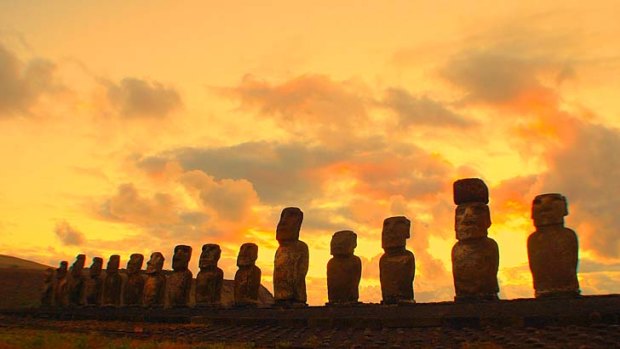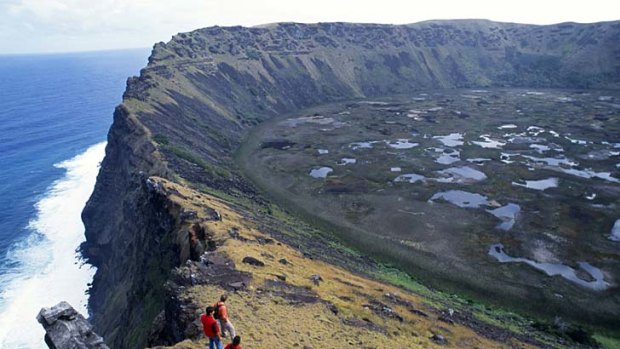
The 15 moai at Ahu Tongariki, Easter Island.Credit: Getty Images
For Bellinda Kontominas, the spirit of Easter Island is reflected in the remarkable faces of its moai.
It takes some time to notice but after a while there is no mistaking it: all the stone statues on the platform before me have markedly different features. Some are short and stocky, others have rounder bellies and some even seem to be smiling. My favourite is a wider-set figure with a square jaw, chin raised proudly and lips pursed in defiance.
These are the famous moai of Easter Island: visually powerful, culturally intriguing and each with a distinct personality. The same can be said for the island itself.

Heads up ... the rim of Rano Kau crater.Credit: Getty Images
A tiny and remote speck in the Pacific Ocean, Easter Island, also known as Rapa Nui, lies almost 2000 kilometres east of Pitcairn Island and is a special territory of Chile, 3700 kilometres away. You won't find a more isolated place on Earth.
Whichever direction you look out to sea, there is nothing but blue ocean to the horizon - apart from the odd fishing boat and those surfing the break in the harbour at Hanga Roa. Most of the island's food must be imported and many of the 5000 residents travel offshore to buy fish in bulk from fleets in the Pacific. At the airport, tourists lug suitcases while locals drag huge portable coolers wrapped in plastic and full of fresh goodies from Santiago.
It's slightly unnerving to feel so far away from the rest of the world but with internet access, television and regular flights from Chile and Tahiti, you're hardly marooned.
For hundreds of years, however, the Rapa Nui people had no contact with the outside world. During this time - between 1000 and the early 1700s - the culture flourished and almost 900 moai were carved from the volcanic rock of the island's quarry, the Rano Raraku crater.
We visit the quarry, where hundreds of moai still lie partly carved. Of these, many stand erect outside the crater, waiting to be brought to life with the final carving of their eye sockets and the addition of white coral and obsidian for the pupils.
Spreading out from the quarry in all directions are almost 100 moai that either fell or were deliberately toppled on their way to being erected on one of the island's many platforms, or ahu. And it is here that the great mysteries of Easter Island unfold. How were these moai, each weighing on average 12.5 tonnes, moved in the first place? And why did the Rapa Nui people deliberately topple some of the moai, which they considered to be sacred?
The answer, in part, lies in the island's lack of trees. A smattering of tall palms fringe Anakena beach, the landing spot of the first inhabitants, according to oral tradition. But the rest of the island is almost treeless, apart from introduced eucalypts. It's an incongruous sight on a Pacific island that at times feels more like the south coast of NSW, with its rolling hills and rugged coastline. The giant palm trees once found across the island are believed to have been cut down to transport the huge stone busts to their platforms. They were also cleared to make way for agriculture and used to build canoes.
This environmental degradation meant there was not enough food to sustain a growing population and canoes could not be built for fishing. This is thought to have triggered tribal wars and prompted people to topple the moai, which had been erected to watch over their safety.
All moai now on platforms have been restored. The 15 moai at Ahu Tongariki were erected after a tsunami in the 1960s had washed one of the figures as far as one kilometre inland.
We visit Ahu Akivi, the only ahu on the island with moai that face out to sea. (The rest face inland towards the former tribal villages.) Our guide, Beno Atan, says these seven moai represent the first Polynesians to discover the island and so face towards their homeland, known as Hera, according to legend.
While it's believed the moai were moved to their ahu using logs or ropes, Atan says oral tradition suggests they "walked" to the platforms via a supernatural power, known as mana.
On the island's southern shores he shows us a meditation circle, in the centre of which is a large, smooth boulder. Those with mana would sit at this circle, he tells us, their hands drawing power from the stone. One theory is this stone received its great power as the place where the umbilical cord of the first-born Rapa Nui was cut.
Atan comes from a line of Rapa Nui dating back generations. His grandfather discovered a female moai made of basalt in the 1950s and he says his father was christened by the famous Norwegian archaeologist Thor Heyerdahl.
"Everybody on the island who is Rapa Nui knows their genealogy," Atan says. "If they don't know, they at least know which tribe they belong to."
On a walk around the island you're bound to stumble upon an archaeological site - there are 20,000 of them. In a grassy inland paddock, we come across ancient Lego-like pieces of carved rectangular volcanic rocks laid out in the shape of canoes. These are the foundations of early Rapa Nui homes. Nearby, circular stone formations that look like giant wells are former greenhouses and chicken coops. We walk further and find a small hole in the ground, the access point to a network of caves formed by the island's lava tubes. Walking through the dark, cramped caves, we're told how Rapa Nui used them as protection from rival tribes. Many of the tubes open (without fencing) to sheer cliffs with 20-metre drops to the crashing waves below. It's a spectacular spot to sit and contemplate the expanse of ocean and sky.
Later, we sip Chilean wine and watch an impossibly beautiful sunset explode in colour behind Ko Te Riku, the only moai with a restored eye.
By the time the first recorded Europeans arrived - Dutch navigator Jacob Roggeveen and his crew landed on Easter Sunday in 1722 (and named it Easter Island accordingly) - the islanders were no longer carving moai.
From about 1760, as part of the intriguing Birdman cult, the Rapa Nui began staging an annual competition to determine which tribal leader would become the earthly representative of the god Makemake. Every September, each chief would sponsor a young man to compete on his behalf. They would climb down the island's steep cliffs, swim to a nearby islet called Motu Nui to snatch the season's first egg laid by the sooty tern, then swim back and try to climb to the cliff top with the egg intact.
Standing at the sacred Birdman site of Orongo, on the edge of the Rano Kau crater, we look down the jagged cliffs at the thrashing surf. It's hard to believe such a feat was ever achieved, let alone once a year.
The winning leader would become the Birdman for a year, during which time he couldn't cut his hair or fingernails and he would receive a virgin who had been kept in a cave for months in preparation, to whiten her skin.
Nearby, the spectacular Rano Kau crater is one of the island's most beautiful sights. Lush with vegetation and ponds from coastal rainfall, the mottled blues and greens are a terrestrial version of the Earth as seen from space. Tourists are not encouraged to walk in the crater unless accompanied by a local; it is dangerously steep and considered a sacred site known for its healing powers. (The drug rapamycin, which counters organ rejection, is made from bacteria sourced from the centre of Rano Kau.)
By 1864, missionaries had arrived on the island and, 14 years later, they put an end to the pagan Birdman competition. Rapa Nui culture dwindled further when the population dropped to just 111 after Peruvian slave raids and the onset of disease.
Later, much of the island was used for sheep farming and the residents were restricted to the town of Hanga Roa.
This dark history is key to understanding why today's islanders are so fiercely proud and protective of their culture. Many young Rapa Nui work as tour guides and most dance or play music in cultural shows. The island has just three small schools and no university, so many people study in mainland Chile or Hawaii, though most return to settle and raise a family on the island.
Within days I feel an inexplicably strong bond to the place. Perhaps it's the archaeological mysteries. Or perhaps it has something to do with mana.
Bellinda Kontominas travelled courtesy of LAN Airlines and Explora.
FAST FACTS
Getting there
Lan Airlines has a fare to Easter Island from Sydney for about $2990 low-season return including tax. You fly to Santiago (about 17hr including transit time in Auckland), then to Easter Island (5hr 40min). Melbourne passengers pay about the same and fly with Qantas to Sydney or Auckland to connect. A night is required in Santiago on the way there at your own expense; see lan.com. A fee of $US95 ($91) is charged on arrival by Chilean Immigration.
Staying there
The Explora Hotel Posada de Mike Rapu Easter Island is on a hill about eight kilometres from the main town of Hanga Roa. Stones from the site have been reset into the building and the lodge is shaped into curved, open pavilions that suit the warm year-round weather and panoramic ocean views. The canoe-shaped ceiling detail is a nod to primitive housing on the island and is one of many beautiful touches in the lodge, built in 2007. There is a massage room, outdoor pool and spa, and a restaurant where you can watch your meal being prepared. Local businessman and deep-sea diving champion Mike Rapu gave permission for South American company Explora to build the hotel on his land. Rooms cost from $2385 a person, twin share, for a three-night package, which includes all meals and beverages and daily excursions with bilingual guides. These include exploration of the moai by foot or bike, snorkelling and fishing trips and entry to the Rapa Nui National Park. Four to eight-night packages are available. Phone +56 2 395 2800, see www.explora.com.
Sign up for the Traveller Deals newsletter
Get exclusive travel deals delivered straight to your inbox. Sign up now.